 |
|||||||||||||||||
|
Daily Web Coverage: Monday Tuesday Wednesday Thursday Friday |
|||||||||||||||||
 |
Eighteenth Meeting of the Animals Committee |
||||||||||||||||
|
San José, Costa Rica, 8-12 April 2002 |
|||||||||||||||||
 |
Tuesday, 9 April Periodic Review of Animal Taxa: The regional representative for North America, serving as the working group Chair, reported on intersessional activities, including the development of review guidelines (AC18/Doc. 8.1/Annex 4) and the rapid assessment technique for the review of animal taxa (AC18/Inf. 13) | ||||||||||||||||
Parnassius apollo: Spain reviewed the status of the Apollo butterfly (Parnassius apollo), recommending that it remain in Appendix II. He said the species has been extirpated in three of its twenty range States and threats to the species are primarily due to collection and habitat destruction. He added that legal trade for this species is low, although illegal trade is believed to be significant. The Secretariat noted that morphological differences of isolated populations are attractive to traders and enquired whether illegal trade is still a major threat. Spain responded that there is illegal catch, although listing under CITES discourages illegal trade and provides a way to track species data. Germany, supported by the representative for Europe and the IWC, said that consultation with butterfly specialists in Germany confirmed that collection is still a threat, and that CITES provides a necessary legal instrument to address regional trade
![]() Listen
to Spain's review
Listen
to Spain's review

Carlos Ibero, Spain

Anas aucklandica: The regional representative for Oceania introduced a review of Brown, Campbell Island and Auckland Islands teal (Anas aucklandica chlorotis, Anas aucklandica nesiotis, and Anas aucklandica aucklandica), stating that trade in these species is very low and could not be expected to be a significant factor of their long-term survival. He added, however, that it is unclear whether de-listing or downlisting to Appendix II will have any impact on commercial demand. Switzerland said that these species should be downlisted from Appendix I to II as they are traded in small quantities and are easily bred in captivity. The UK said that the species meets the biological criteria, but doubtfully the trade criteria, for continued listing on Appendix I
Cnemidophorus hyperythus: The US reported that the orange-throated whiptail lizard (Cnemidophorus hyperythus), which occurs in California and Mexico, is threatened mainly by habitat destruction, with international trade limited to museum specimens. Pointing out that both California and Mexico have protection legislation in place, he recommended de-listing the species. Israel objected, maintaining that there is not enough information to de-list. The Humane Society of the US said it is difficult to ascertain the impacts of small levels of trade with minimal information. The Western Association of Fish and Wildlife Agencies expressed doubt that CITES provisions are protecting the species
Keith Davenport, Ornamental Aquatic Trade Association

Review of the guidelines for the periodic review of Animal Taxa: The US explained that the draft guidelines cover three areas: objective of the periodic review process; identification of species to be reviewed; and process for future reviews. Chair Hoogmoed, and others, questioned the exclusion of high "visibility" species. The IWC added that high visibility species were excluded to reduce biases based on political agendas. Oceania called for a study to determine if reduced trade after a review is due to CITES or to other factors. The Netherlands stressed that a review may lead to uplisting, and therefore reviews should look at species with high levels of trade
Evaluation of crocodile ranching operations: The Crocodile Specialist Group reported on their research on crocodile ranching operations, production, and the global crocodile skin trade. He said that, with funding, it would be possible to monitor the effects of ranching on wild populations. He noted such ranching issues as: compliance with reporting requirements; admixture of stock from ranches and captive breeding operations; and source coding. Chair Hoogmoed proposed that the Animals Committee continue to consider crocodile ranching at their next meeting, with the possibility of addressing non-crocodilian species. Germany supported the idea of considering the question of ranching in cases such as parrots and invertebrates
Javier Alvarez, USA
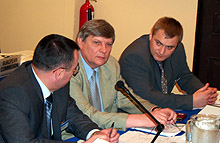
Breeding Appendix I Animal Species for Commercial Purposes: The Secretariat introduced the document on Registration and Monitoring of Operations Breeding Appendix I Species for Commercial Purposes (AC18/Doc. 9), calling for a pilot project to compile three alternative lists of Appendix I species that are considered difficult to keep or breed in captivity. The project was limited to Appendix I reptile species and reptiles evaluated by the IUCN as being "Critically Endangered," "Endangered" or "Vulnerable." The IUCN/SSC Crocodile Specialist Group described the report, noting the project is designed to facilitate implementation of captive breeding provisions, but that the results do not address the relationship between ex situ captive production systems and in situ conservation and management. He also said that there was difficulty reconciling the IUCN Red List with Appendix I listings
Delegates from the Russian Federation

Relationshis between EX SITU Production and IN SITU conservation: The Secretariat introduced the document (AC18/Doc. 10), emphasizing that captive breeding should not harm in situ conservation, and raising the possibility of adopting a risk assessment approach. Chile observed that economic benefits of captive breeding and market mechanisms could support conservation in range areas. The World Association of Zoos and Aquariums emphasized focusing on negative socioeconomic and intellectual property aspects of captive breeding. The Secretariat said socioeconomic issues cannot be separated from conservation. Project Seahorse urged the Animals Committee to examine captive breeding with either no conservation impact or a positive impact on in situ conservation, and supported the use of risk assessment. The Secretariat will recommend to COP-12 that this matter be kept on the Animals Committee agenda
Don Bruning, WCS
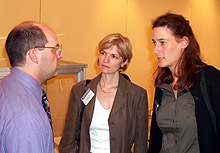
Trade in Traditional Medicines: Species Traded for Medicinal Purposes: IFAW introduced the List of Species Traded for Medicinal Purposes (AC18/Doc. 13.1), stating that records are often unclear on medicinal use and on international trade of CITES-listed species for medicinal purposes. The Secretariat emphasized that resources do not exist for more research. China said the significant trade review process addresses concerns regarding trade in traditional medicines. Project Seahorse questioned the viability of and justification for the approach. The Animal Welfare Institute called for investigation into alternatives to CITES-listed species. The US suggested that the List should be organized by taxonomy, and include CITES species traded as derivatives or parts, common names, geographic distribution, levels of trade, countries of origin, importing countries, source codes, and use in modern medicinal systems. The Humane Society of the US suggested forwarding information on tiger trade to the Standing Committee. The Secretariat proposed, and delegates supported, convening a contact group to discuss the matter
Bruce Weissgold, USA (left), with Rosalind Reeve and Daniela Freyer (Pro Wildlife)
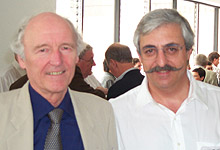
Jacques Berney, IWMC, with Arman Petrossian, ICIA
Trade in Tursiops truncatus ponticus: The US presented results of the report (AC18/ Doc. 16.1 and AC18/Inf. 2) on the biological and trade status of the Black Sea bottlenose dolphin (Tursiops truncatus ponticus). She noted the resolution of the Agreement on the Conservation of Cetaceans of the Black Sea, Mediterranean Sea and contiguous Atlantic Area (ACCOBAMS) banning importation of this species and, similar to the Bern Convention, calling for the species' transfer to Appendix I. Oceania, with the UK, Switzerland and the IWMC, noted that the level of reported trade and population statistics do not indicate a large trade effect compared to other impacts. The US urged that further threats, including trade, be avoided. Israel opposed the imposition of a zero export quota, and with IFAW and Pro Wildlife, called for endorsing the ACCOBAMS recommendation. Israel and the US suggested that the Animals Committee make a clear recommendation to COP-12 on this issue. Germany pointed out that uplisting requires certain biological criteria, but does not require that trade is the most significant threat

Teresa Telecky (left), Nancy Daves and Juan Agustin Iriate

Captive Breeding of CITES Species for Medicinal Purposes: Introducing the report (AC18/Doc. 13.2), the Secretariat called for the compilation of an inventory of CITES species used for traditional medicines. He questioned the inventory's conservation value, acknowledged the benefit of having a tracking procedure, and asked for advice from the Animals Committee on how to proceed. The representative for North America, supported by Oceania, suggested identifying cases with conservation benefits to establish the need for the inventory
Transport of Live Animals: Germany, Chair of the working group on transport of live animals, presented their report of work (AC18/Doc. 11.1), including collecting data on transport injury and mortality, review and adoption of related guidelines, and establishment of an animal transport database. The representative for Europe noted mortality issues before and after transportation, urging consideration of issues such as animal welfare laws. Switzerland stressed the importance of training airport personnel and proper airport facilities. WAZA noted they are offering related courses in Europe
Perran Ross, IUCN, CSG

Trade
in Hard Corals: The UK, Chair of the working group introduced the report on trade in hard corals (AC18/Doc. 12.1), advising the Secretariat on coral genera recognition at the genus and species level. He noted difficulties with identifying corals, both live and dead, since there is a minimum of 600 reef-building coral species currently in trade, many similar in appearance. He recommended that corals be identified on permits at the genus level when it is not possible to identify a specimen at the species level. The Animal Committee adopted the report
![]() Listen
to the report of the Working Group
Listen
to the report of the Working Group
PROGRESS ON THE FIRST COUNTRY-BASED SIGNIFICANT TRADE REVIEW: Madagascar announced that it is initiating a six-month moratorium on wildlife export due to political domestic problems and lack of a CITES Scientific Authority to monitor trade. She said permits will only be issued once a Scientific Authority is in place. The Secretariat said it will cooperate with Madagascar in combating illegal trade and hoped the situation would improve so that a CITES mission could support capacity-building. As one of the largest importers of wildlife from Madagascar, the US expressed concern with the situation and offered to assist with developing national laws to prevent the illegal trade of species. The David Shepherd Conservation Foundation noted that the illegal trade of Madagascar species through the Comoros could circumvent the moratorium
Yolanda Matamoros Hidalgo, Costa Rica
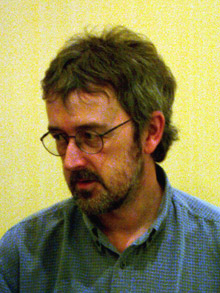
Universal Labelling of Caviar: Introducing the report from the working group on labelling of caviar (AC18/Doc. 15.1and 15.2), Oceania, working group Chair, reported on results of intersessional activities and an informal meeting held on Monday evening, 8 April. He explained that the resolution on caviar does not address labelling in the case of re-exportation, the group has been asked to redraft the Resolution to cover the issue and submit it to COP-12. The Secretariat highlighted a suggestion on merging resolutions on caviar and sturgeon, which will be addressed by the working group. He added that almost all Caspian Sea countries have implemented the labelling system for caviar export, and many Black Sea countries are in the process of doing so
Vincent Fleming, UK
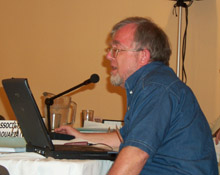
Peter Dollinger, Executive Director, WAZA
|
Links: ENB coverage of The Eleventh Conference of the Parties (COP-11) |